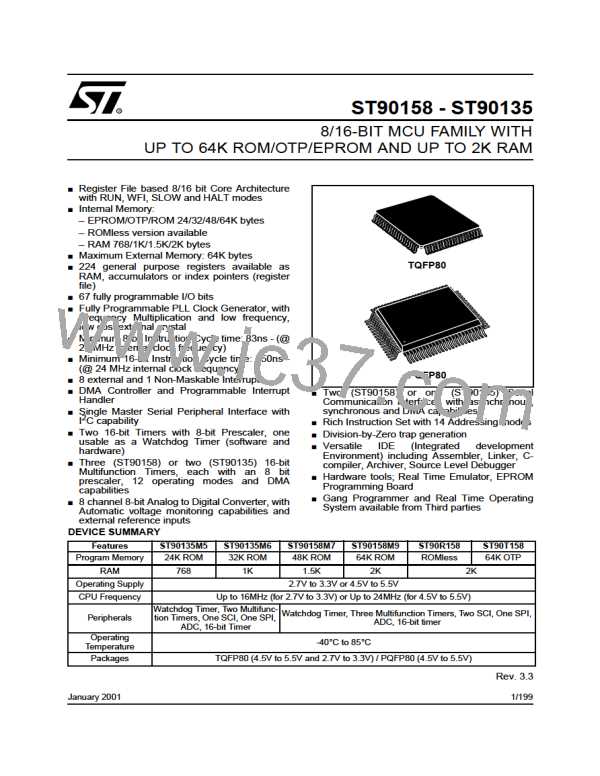ST90158 - SERIAL PERIPHERAL INTERFACE (SPI)
9.5.3.1 Input Signal Description
SERIAL PERIPHERAL INTERFACE (Cont’d)
9.5.3 Functional Description
The SPI, when enabled, receives input data from
the internal data bus to the SPI Data Register
(SPIDR). A Serial Clock (SCK) is generated by
controlling through software two bits in the SPI
Control Register (SPICR). The data is parallel
loaded into the 8 bit shift register during a write cy-
cle. This is shifted out serially via the SDO pin,
MSB first, to the slave device, which responds by
sending its data to the master device via the SDI
pin. This implies full duplex transmission if 3 I/O
pins are used with both the data-out and data-in
synchronized with the same clock signal, SCK.
Thus the transmitted byte is replaced by the re-
ceived byte, eliminating the need for separate “Tx
empty” and “Rx full” status bits.
Serial Data In (SDI)
Data is transferred serially from a slave to a mas-
ter on this line, most significant bit first. In an S-
2
BUS/I C-bus configuration, the SDI line senses
the value forced on the data line (by SDO or by an-
other peripheral connected to the S-bus/I C-bus).
2
9.5.3.2 Output Signal Description
Serial Data Out (SDO)
The SDO pin is configured as an output for the
master device. This is obtained by programming
the corresponding I/O pin as an output alternate
function. Data is transferred serially from a master
to a slave on SDO, most significant bit first. The
master device always allows data to be applied on
the SDO line one half cycle before the clock edge,
in order to latch the data for the slave device. The
SDO pin is forced to high impedance when the SPI
is disabled.
When the shift register is loaded, data is parallel
transferred to the read buffer and becomes availa-
ble to the CPU during a subsequent read cycle.
The SPI requires three I/O port pins:
2
During an S-Bus or I C-Bus protocol, when arbi-
tration is lost, SDO is set to one (thus not driving
the line, as SDO is configured as an open drain).
SCK
SDO
SDI
Serial Clock signal
Serial Data Out
Serial Data In
Master Serial Clock (SCK)
An additional I/O port output bit may be used as a
slave chip select signal. Data and Clock pins I²C
Bus protocol are open-drain to allow arbitration
and multiplexing.
The master device uses SCK to latch the incoming
data on the SDI line. This pin is forced to a high im-
pedance state when SPI is disabled (SPEN,
SPICR.7 = “0”), in order to avoid clock contention
from different masters in a multi-master system.
The master device generates the SCK clock from
INTCLK. The SCK clock is used to synchronize
data transfer, both in to and out of the device,
through its SDI and SDO pins. The SCK clock
type, and its relationship with data is controlled by
the CPOL (Clock Polarity) and CPHA (Clock
Phase) bits in the Serial Peripheral Control Regis-
ter (SPICR). This input is provided with a digital fil-
ter which eliminates spikes lasting less than one
INTCLK period.
Figure 66 below shows a typical SPI network.
Figure 66. A Typical SPI Network
Two bits, SPR1 and SPR0, in the Serial Peripheral
Control Register (SPICR), select the clock rate.
Four frequencies can be selected, two in the high
frequency range (mostly used with the SPI proto-
col) and two in the medium frequency range
(mostly used with more complex protocols).
n
135/199
9

 ETC [ ETC ]
ETC [ ETC ]